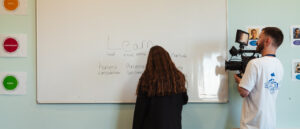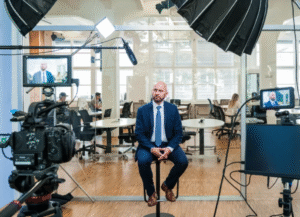Building on projects with London councils and global firms such as Google & AstraZeneca (offering young people work experience placements), we’ve created a framework designed to place your students (or service users) at the heart of the content creation process.
While standard “promo” videos for schools and education providers do a great job of capturing achievements and showcasing your unique way of inspiring young people, the real magic happens when students help define the brief and the need for change, frame the questions and shape the story, instead of just sitting for an interview.
Studies on youth-participatory projects show that when pupils are involved in the production process and present the final film, their confidence increases, they feel empowered and feel a sense of ownership around the final product.
If you want to strengthen ties with local employers (whether through offering work-experience placements or simply build goodwill in your local community), taking a student-led approach delivers many additional benefits.
Working as teams, students gain transferable skills that translate directly into standout CV’s, new perspectives, successful college applications and early career opportunities.
The Seven-Phase Engagement Cycle
1. Purpose & Stakeholder Alignment
Convene school leaders, students, parents and (where relevant) business partners to agree why a story project matters and who it should serve. Pin down one or several specific, measurable goals, (e.g., “grow STEAM placements by 30%” or “launch a mentoring or work experience program by X date”). Schools that invite pupils to investigate local issues, co-design solutions and tell the story themselves achieve multiple outcomes at once, including:
- Community impact – solutions reflect real needs because residents, businesses and students shaped them.
- Overcome recruitment challenges – attract the best quality candidates/new qualified teachers to your school.
- Youth opportunity – young people gain skills, social capital and a public portfolio that opens doors to education and work.
The project with Camden Learning began with a workshop where employers, teachers and students identified what they wanted from the films, resulting in 2 distinct audiences (businesses & young people).
Read the case study and see other films we produced for Camden Learning here.
2. Co-Discovery & Story Framing
Run quick research sessions, student surveys, on-location interviews, values-mapping and exploration. This helps to uncover the angles/over arching narrative that feel authentic. Draft a one-page story canvas that defines audience, conflict, resolution and call-to-action. Students co-select the questions focused on HOW and the WHO – (e.g. “Who will we need to feature or interview?” “How will we achieve our objectives?”) and set success metrics.
The project with Oasis Enfield involved delivering focus groups with pupils, to identify personal stories that relate to their “LEARN” values (Leadership, Enthusiasm, Achievement, Respect, Nurture). Those moments became the spine of the final narrative.
Read the case study for our work with Oasis Academy Enfield here.
3. Skills Training & Pre-Production
Assign different roles and responsibilities to different students, or groups of students. Assemble a student media crew, roles within which may rotate between participants. Deliver bite-sized workshops on interviewing, scriptwriting, consent and safeguarding. Decide if you want to focus on the production of content filmed on mobile phones or professional equipment for higher production values. Scout locations and lock-in a production plan that works for everyone who will take part.
Richmond Park Academy we ran a series of workshops for year-10 media students over a series of afternoons; they shadowed our crew, capturing B-roll the main camera couldn’t.
Read the full case study for our work with Richmond Park Academy here.
4. Live Engagement & Production
Students lead or co-lead events: workplace visits, project builds, interview shoots. The crew documents genuine interactions, avoiding scripted “PR smiles.”
Our work with Camden Learning involved filmed students during their placements at Google, AstraZeneca and Digital Catapult, letting reactions unfold unscripted.
5. Post-Production & Multi-Format Crafting
Edit footage into a hero film (2-3 min) and several cut-downs (<60s for social, 5-8 min for deep dives). Introduce students to the editing process, Involve them in rough-cut reviews so their voice remains intact.
All three projects approved audience-specific edits: Camden produced business-facing and student-facing cuts; The promo we produced for Oasis Learning focused on the principal’s vision and the 5 values the school stood for.
6. Launch, Dialogue & Activation
Premiere the hero film at an assembly, or invite parents and local business leaders to a launch event; push shorts on TikTok, Instagram, LinkedIn; embed introductions to teachers and students on your website. Pair each release with a call-to-action (sign up, volunteer, apply).
Richmond Park Academy hosted their film on social media as well as their website at promoted in at their open day and at community fairs – leading to an increase in applications to join at the start of the school year.
7. Evaluation, Reflection & Next Cohort
Collect analytics (views, enquiries, placement sign-ups) and qualitative feedback (student journals, parent feedback). Publish an “impact snapshot” and refine the approach for the next year’s cohort.
Camden Learning measured a rise in employer interest and student confidence surveys, feeding those numbers into its STEAM-pipeline strategy for 2025.
Success Metrics (choose those that apply)
- Learning outcomes: % of students who report new skills, career awareness, or increased confidence.
- Community value: volunteer hours logged, funds or materials donated, footfall to revitalised spaces.
- Content reach: views, shares, sentiment of comments, local press citations.
- Sustainability gains: kWh saved, waste diverted, biodiversity indicators.
- Equity & inclusion: diversity of student participants and featured voices.
What Schools Gain
| Benefit | How Behind the Goal Delivers |
|---|---|
| Curriculum enrichment | Media, English, PE and PSHE links through authentic projects. |
| Career visibility | Pupils meet a range of professionals and get an insight into different career paths: communications, marketing, PR, cooks, analysts, content editors, HR- some of which were careers they never knew existed. |
| Skills & accreditation | Learners earn digital badges in video production, interviewing and project management. |
| Community profile | High-quality, student authored content elevates the school brand, on and offline. |
| Inclusive opportunity | We deliver bespoke programs for SEN hard-to-engage pupils (for example when working with PRU’s) to ensure the marginalised or under-represented voices feel heard. |
First Steps For Your School
- Map allies – list local businesses, charities, council teams and national bodies already working on sustainability, social equity, mentorship, apprenticeship or work experience placements.
- Run a “story lab taster” afternoon – small, low-stakes pilot that walks students through phases 1-3.
- Secure micro-funding – PTA, local enterprise partnership or a CSR grant can cover equipment and stipends.
- Document ruthlessly – every pilot clip, quote and learning fuels the narrative assets, proving the model works.
‘Behind The Goal’
Fluent Media founder, Matt Castle, has spent the past decade helping schools turn their students’ voices into powerful films. From Camden Learning’s STEAM placements to the values-led narratives of Richmond Park Academy and Oasis Academy Enfield, we’ve seen a recuring pattern: when young people co-create the story, they unlock confidence, skills and networks that formal lessons alone can’t reach.
Behind the Goal is our next evolution – a programme that fuses that proven, story-led method with the world’s most universal language: football. Working hand-in-hand with professional clubs, corporate partners and local schools, we offer pupils a front-row seat – and a backstage pass – to careers on and off the pitch. Learn more here.
Implementation Roadmap
Book a 30-minute discovery call with Fluent Media to align on your first pilot, set KPIs and lock in the training calendar for the upcoming term.
https://calendly.com/matt-fluentmedia/30min









